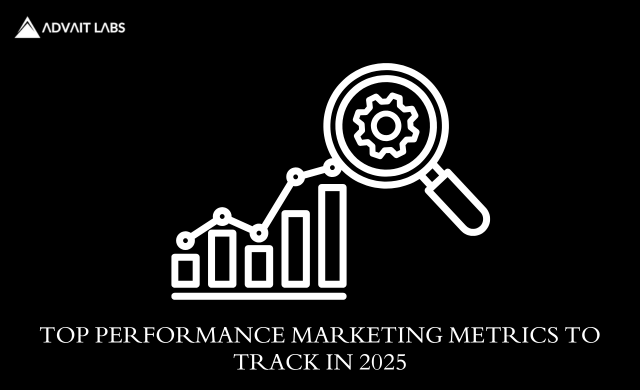Performance Marketing Metrics You Should Track in 2025

If you’re a business owner or marketer looking to improve your campaigns, understanding performance marketing is essential. Unlike traditional marketing, performance marketing focuses on measurable results, ensuring every dollar spent drives a tangible outcome. At Advait Labs in Hyderabad, we help brands optimize their marketing efforts by tracking the most critical metrics.
In this blog, we’ll explore the key performance marketing metrics you should track in 2025, explain what is performance marketing, compare performance marketing vs digital marketing, and guide you in making data-driven decisions.
What is Performance Marketing?
Simply , performance marketing is a results-driven strategy where advertisers pay only when a specific action is completed. This action could be a click, a sale, a lead, or a download.
Unlike traditional advertising that focuses on impressions or reach, performance marketing ensures accountability and measurable ROI. Every campaign is designed to deliver results, making it one of the most efficient marketing approaches today.
Performance Marketing vs Digital Marketing: Understanding the Difference
Here’s a simple distinction:
- Digital Marketing: A broad umbrella encompassing all online marketing activities—SEO, social media, email campaigns, and display advertising. Success is often measured in engagement, impressions, or brand awareness.
- Performance Marketing: A subset of digital marketing that focuses strictly on measurable outcomes. Payment is tied to actions rather than exposure, ensuring higher ROI and accountability.
Key Performance Marketing Metrics to Track in 2025
To succeed in performance marketing, tracking the right metrics is crucial. Here are the metrics that will define effective campaigns in 2025:
1. Cost Per Acquisition (CPA)
Definition: CPA measures the cost incurred to acquire a customer or lead.
Why it matters: CPA is one of the most direct indicators of campaign efficiency. A lower CPA means your marketing efforts are cost-effective and reaching the right audience.
Example: If you spend ₹50,000 on a campaign and acquire 200 customers, your CPA is ₹250.
2. Return on Ad Spend (ROAS)
Definition: ROAS calculates the revenue generated for every rupee spent on advertising.
Why it matters: This metric helps you understand which campaigns are profitable and which need optimization. A ROAS greater than 1 indicates positive returns.
Pro tip: At Advait Labs, we focus on campaigns with ROAS above 3 to ensure maximum profitability.
3. Click-Through Rate (CTR)
Definition: CTR is the percentage of people who click your ad after seeing it.
Why it matters: CTR indicates the effectiveness of your ad copy, visuals, and targeting. A higher CTR means your message resonates with your audience.
Benchmark: Aim for a CTR of at least 2-3% for display ads and higher for search campaigns.
4. Conversion Rate
Definition: Conversion rate measures the percentage of visitors who complete a desired action, such as signing up, purchasing, or downloading.
Why it matters: This metric shows how well your landing pages and campaigns convert visitors into customers. High traffic without conversions is a wasted opportunity.
Tip: Optimize your landing pages for mobile and speed to improve conversions.
5. Customer Lifetime Value (CLV)
Definition: CLV estimates the total revenue a business can expect from a customer over their relationship with the brand.
Why it matters: CLV helps you decide how much you can spend on acquiring customers profitably. A higher CLV justifies a higher CPA.
Example: If a customer spends ₹5,000 annually for three years, their CLV is ₹15,000.
6. Engagement Rate
Definition: Engagement rate measures interactions with your content, such as likes, shares, comments, or video views.
Why it matters: While engagement doesn’t always result in immediate sales, it builds brand trust and loyalty. Tracking this alongside performance metrics provides a holistic view of campaign success.
7. Bounce Rate
Definition: Bounce rate is the percentage of visitors who leave your site after viewing only one page.
Why it matters: A high bounce rate may indicate irrelevant traffic, poor landing page design, or weak messaging. Reducing bounce rate improves conversion rates and overall campaign efficiency.
8. Impression Share
Definition: Impression share represents the percentage of times your ad is shown compared to the total available impressions.
Why it matters: This metric helps you understand your brand’s visibility in competitive markets and identify opportunities to capture more audience attention.
Summary
Performance marketing is a results-driven approach that ensures every marketing effort is measurable and accountable. By tracking metrics like CPA, ROAS, CTR, conversion rate, CLV, engagement, bounce rate, and impression share, you can make informed decisions that boost ROI.
If you want to take your campaigns to the next level in 2025, tracking these metrics and optimizing accordingly is non-negotiable. Trust experts like Advait Labs in Hyderabad to guide you through data-driven performance marketing strategies.
FAQs
1. What is performance marketing, and how does it work?
Performance marketing is a results-driven approach where advertisers pay only for completed actions, such as clicks, leads, or sales. Campaigns are designed to ensure measurable ROI, making every marketing spend accountable.
2. How is performance marketing different from digital marketing?
While digital marketing covers all online marketing efforts, performance marketing is a subset focused on measurable outcomes and payment based on results. Not all digital marketing campaigns guarantee results, but performance marketing does.
3. Which performance marketing metrics are most important in 2025?
Key metrics include CPA, ROAS, CTR, conversion rate, CLV, engagement rate, bounce rate, and impression share. Tracking these ensures campaigns are cost-effective and result-driven.
4. How can Advait Labs help businesses with performance marketing in Hyderabad?
Advait Labs specializes in optimizing campaigns for maximum ROI, tracking essential metrics, and bridging the gap between performance marketing vs digital marketing to deliver measurable results.
5. Why is tracking ROAS crucial in performance marketing?
ROAS (Return on Ad Spend) measures the revenue generated per rupee spent on advertising. Tracking ROAS ensures campaigns are profitable and helps allocate budget to the best-performing channels.
